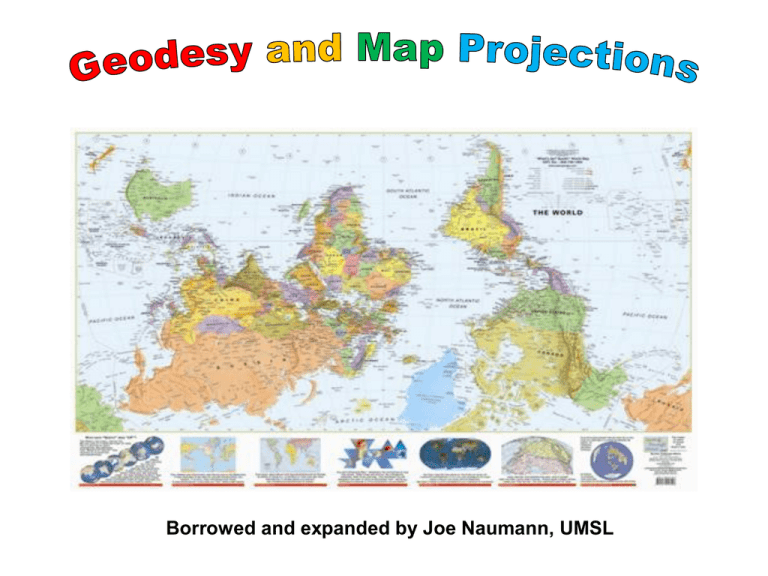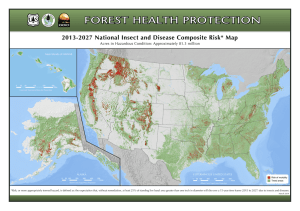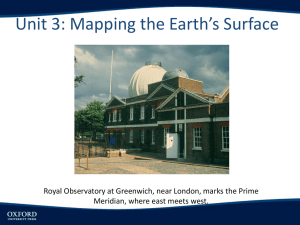Understanding Geodesy and Map Projections
advertisement

Borrowed and expanded by Joe Naumann, UMSL What is a Map Projection? It is how we represent a three dimensional Earth on a flat piece of paper However… The process of transferring information from the Earth to a map causes every projection to distort at least one aspect of the real world – either shape, area, distance, or direction. Is this a “good” map of the Earth? Mercator Projection and the “Greenland Problem” Also known as Northern Hemisphere dominant projection How about this? Infamous Peters projection of 1974 - Equal Area, True Direction Shape (conformality) and Distance Not Preserved The Answer It depends • A “good” map is one that is being successfully used for its intended purpose and was created in a precise and accurate manner • Always a trade-off in errors – – – – Shape (Conformal) Distance Area Direction (Local angles) • Can only keep one or two of these accurate • OR compromise between all four • Errors may not be significant for small study areas but they do exist Robinson Projection -a compromise projection Shortest distance between two points???? Mercator Maps used as Charts in Navigation (Ships and Planes) Basic Definitions • Geodesy - The science of determining the size and shape of the earth and the precise location of points on its surface. • Map Projection - the transformation of a curved earth to a flat map. • Coordinate systems – Any set of numbers, usually in sets of two or three, used to determine location relative to other locations in two or three dimensions Types of Coordinate Systems • (1) Global Cartesian coordinates (x,y,z): A system for the whole earth • (2) Geographic coordinates (f, l, z) • (3) Projected coordinates (x, y, z) on a local area of the earth’s surface • The z-coordinate in (1) and (3) is defined geometrically; in (2) the z-coordinate is defined gravitationally Global Cartesian Coordinates (x,y,z) Z Greenwich Meridian • O Y X Equator Extremely cumbersome and difficult to relate to other locations when translated to two dimensions. Geographic Coordinates (Latitude and Longitude) (f, l, z) • Latitude (f) and Longitude (l) defined using an ellipsoid, an ellipse rotated about an axis • Elevation (z) defined using geoid, a surface of constant gravitational potential • Earth datums define standard baseline values of the ellipsoid and geoid (more on this later….) • Usually used in general purpose atlases and maps and textbooks. Origin of Geographic Coordinates Equator (0,0) Prime Meridian Latitude and Longitude Lines of latitude are called “parallels” Lines of longitude are called “meridians” The Prime Meridian passes through Greenwich, England Latitude and Longitude in North America 90 W Length on Meridians and Parallels (Lat, Long) = (f, l) Length on a Meridian: AB = Re Df (same for all latitudes) R Dl Re Length on a Parallel: CD = R Dl = Re Dl Cos f (varies with latitude) R C Df B Re A D How Do We Define the Shape of the Earth? We think of the earth as a sphere It is actually a spheroid, slightly larger in radius at the equator than at the poles Ellipsoid or Spheroid Rotate an ellipse around an axis Z b a O a X Rotational axis Y Selection of the Spheroid is what determines the SIZE of the Earth Horizontal Earth Datums (Making sure we are where we think we are….) • What is a datum???? • An earth datum is defined by a specific ellipse and an axis of rotation • NAD27 (North American Datum of 1927) uses the Clarke (1866) ellipsoid on a non geocentric axis of rotation • NAD83 (NAD,1983) uses the GRS80 ellipsoid on a geocentric axis of rotation • WGS84 (World Geodetic System of 1984) uses GRS80, almost the same as NAD83 Representations of the Earth Mean Sea Level is a surface of constant gravitational potential called the Geoid Sea surface Ellipsoid Earth surface Geoid Since the Geoid varies due to local anomalies, we must approximate it with a ellipsoid Geoid and Ellipsoid Earth surface Ocean Geoid Gravity Anomaly North American Datum of 1927 (a very common horizontal datum – “old” data) Uses the Clarke 1866 Spheroid which minimizes error between the spheroid and the geoid at Meades Ranch, Kansas. (The center of the U.S.; unfortunately, not the world.) 1866 Spheroid (Clarke) Spheroid Center Mass Center of Earth Geoid Meades Ranch, Kansas Earth surface North American Datum of 1983 (a very common horizontal datum – “newer” data) Uses the GRS80 Spheroid which minimizes error between the spheroid and the geoid on average around the world. (Resulting in a spheroid center much closer to the mass center of the Earth.) GRS80 Ellipsoid Ellipsoid Center Mass Center of Earth Geoid Meades Ranch, Kansas Earth surface Vertical Earth Datums • A vertical datum defines the “zero reference” point for elevation, z • NGVD29 (National Geodetic Vertical Datum of 1929) • NAVD88 (North American Vertical Datum of 1988) • Takes into account a map of gravity anomalies between the ellipsoid and the geoid which are relatively constant. Earth surface Ocean Geoid Gravity Anomaly Map Projection Flat Map Cartesian coordinates: x,y (Easting & Northing) Curved Earth Geographic coordinates: f, l (Latitude & Longitude) Earth to Globe to Map Map Scale: Map Projection: Scale Factor Representative Fraction = Globe distance Earth distance (e.g. 1:24,000) = Map distance Globe distance (e.g. 0.9996) Geographic and Projected Coordinates (f, l) Map Projection (x, y) Projection onto a Flat Surface (Three Broad Classes by Light Source) Gnomonic Projection Stereographic Projection Orthographic Projection World from Space – Orthographic Projection Types of Projections Types of Projections Equal Area: maintains accurate relative sizes. Used for maps that show distributions or other phenomena where showing area accurately is important. Examples: Lambert Azimuthal Equal-Area, the Albers Equal-Area Conic. Often used for small scale world maps or hemispheric maps. Conformal: maintains angular relationships and accurate shapes over small areas. Used where angular relationships are important, such as for navigational or meteorological charts. Examples: Mercator, Lambert Conformal Conic. Easier for younger students to learn the continents by shape. Equidistant: maintains accurate distances from the center of the projection or along given lines. Used for radio and seismic mapping, and for navigation. Examples: Equidistant Conic, Equirectangular. Azimuthal or Zenithal: maintains accurate directions (and therefore angular relationships) from a given central point. Used for aeronautical charts and other maps where directional relationships are important. Examples: Gnomonic projection, Lambert Azimuthal Equal-Area. Often used for maps of countries or large regions of continents View maps critically: Does this map show the selected information accurately or does it show a bias of its maker (has compromised accuracy)? Conic Projections (Albers, Lambert) The lines where the cone is tangent or secant are the places with the least distortion. Planar or Azimuthal (Lambert) Cylindrical Projections (Mercator) The lines where the cylinder is tangent or secant are the places with the least distortion. Transverse Oblique Mercator Projections Projections Preserve Some Earth Properties • Area - correct earth surface area (Albers Equal Area) important for mass balances • Shape - local angles are shown correctly (Lambert Conformal Conic) • Direction - all directions are shown correctly relative to the center (Lambert Azimuthal Equal Area) • Distance - preserved along particular lines • Some projections preserve two properties • Some projections preserve none of the above but attempt to minimize distortions in all four • The degree and kinds of distortion vary with the projection used. Some projections are suited for mapping large areas that are mainly north-south in extent, others for large areas that are mainly east-west in extent. Coordinate Systems • Hydrologic calculations are done in Cartesian or Planar coordinates (x,y,z) • Earth locations are measured in Geographic coordinates of latitude and longitude (f,l) • Map Projections transform (f,l) (x,y) Coordinate System A planar coordinate system is defined by a pair of orthogonal (x,y) axes drawn through an origin Y X Origin (xo,yo) (fo,lo) Commonly used coordinate systems and associated projections • State Plane (Texas, California, etc) – Usually is a Lambert Conformal Conic projection (not always) • • • • Reference meridian Two standard parallels Good for East-West areas Commonly used by state and local governments for GIS databases • Broken into appropriate sections representing areas of the state – Coordinate System is in Feet – False Easting (FE), False Northing (FN) • Reference Latitude • Central Meridian • (0 + FE, 0 + FN) is origin of coordinate system Universal Transverse Mercator Coordinate System • Uses the Transverse Mercator projection • Each zone has a Central Meridian (lo), zones are 6° wide, and go from pole to pole • 60 zones cover the earth from East to West • Reference Latitude (fo), is the equator • (Xshift, Yshift) = false easting and northing so you never have a negative coordinate – This time in METERS!!!!! • Commonly used by federal govt agencies such as USGS (also a few states) Mercator Projection The only map on which a straight line drawn anywhere within its bounds shows a particular type of direction, but distances and areas are grossly distorted near the map's polar regions. UTM Projection (Zone 15) UTM Zone 14 -99° -102° -96° 6° Origin -120° -90 ° Equator -60 ° Universal Transverse Mercator Projection Summary Concepts • Two basic locational systems: geometric or Cartesian (x, y, z) and geographic or gravitational (f, l, z) • Mean sea level surface or geoid is approximated by an ellipsoid to define a horizontal earth datum which gives (f, l) and a vertical datum which gives distance above the geoid (z) Summary Concepts (Cont.) • To prepare a map, the earth is first reduced to a globe and then projected onto a flat surface • Three basic types of map projections: – conic – cylindrical – Planar/azimuthal • A particular projection is defined by a datum, a projection type and a set of projection parameters Summary Concepts (Cont.) • Standard coordinate systems use particular projections over zones of the earth’s surface • Types of standard coordinate systems: – UTM – State Plane – Others too numerous to mention • Do not confuse the coordinate system of a set of datum for its projection – Example: A shapefile that uses the Texas State Plane Coordinate System is in the Lambert Conformal Conic Projection Interrupted projections to maintain equal-area and be relatively conformal Good for studying land areas, but not very good for ocean studies. What you get if you don’t interrupt Areas may be equal (proper proportions); however, shapes are greatly distorted the farther one gets from the center of the projection Adapted to Keep Oceans together Unusual Special Purpose Projections Cylindrical equal-area projection with oblique orientation Peters is an equal-area projection which became the centerpiece of a controversy surrounding the political implications of map design The Hammer-Aitoff Projection This orientation is used in Australian geography textbooks (probably N.Z. too) This is only a sample – the variety is almost endless The cartographer (map maker) will, one hopes, make choices carefully to truthfully communicate graphic information about the earth and parts. Unfortunately some people or groups want to push a particular agenda rather than truthfully inform people. Example: The Soviet Union was about 2.5 times larger than the U.S.A. (a fact). However, some overly militant Americans would show the countries on a Mercator projection and the Soviet Union would look 3.5 to 4 times bigger than the U.S. – their purpose was to scare people into supporting greater defense spending during the Cold War. See the next slide. Ro Mercator Projection – conformal but distorts area, particularly at high latitudes. Robinson equal-area projection keeps areas in correct proportion but distorts shape somewhat at high latitudes. What does all this mean??? • Careful attention must be paid to the projection, datum and coordinate system for every piece of GIS data used. • Failure to use data from the same system OR change the data (re-project) it to the desired system will result in overlay errors – Can range some small to SIGNIFICANT – Real danger is when the errors are small (possibly unnoticed) • Shapefiles, images, grids all have this data inherent in their very creation. – Usually included in a system of files known as “metadata” or xxxxxx.PRJ file. • Not only must a person select the projection which will most accurately convey the information to the viewer, but attention must also be paid to obtaining data from the same data system so that the computer will properly merge the layers • Gone are the days of the creatively hand-drawn maps of my youth. The thrill upon successful completion was fantastic, but GIS can be much more precise. Turned upside down yet?????? Excellent website: http://erg.usgs.gov/isb/pubs/MapProjections/projections.html


